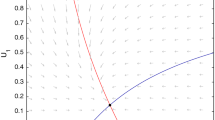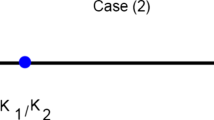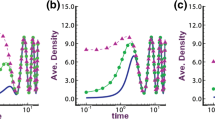Abstract
The effects of habitat heterogeneity on a diffusing population are investigated here. We formulate a reaction-diffusion system of partial differential equations to analyze the effect of resource allocation in an ecosystem with resource having its own dynamics in space and time. We show a priori estimates to prove the existence of state solutions given a control. We formulate an optimal control problem of our ecosystem model such that the abundance of a single species is maximized while minimizing the cost of inflow resource allocation. In addition, we show the existence and uniqueness of the optimal control as well as the optimal control characterization. We also establish the existence of an optimal intermediate diffusion rate. Moreover, we illustrate several numerical simulations with Dirichlet and Neumann boundary conditions with the space domain in 1D and 2D.
























Similar content being viewed by others
References
Antil H, Kouri DP, Lacasse M-D, Ridzal D (2018) Frontiers in PDE-constrained optimization, volume 163. Springer, Berlin
Bintz J, Lenhart S (2020) Optimal resource allocation for a diffusive population model. J Biol Syst 28(04):945–976
Borzì A, González AS (2015) Second-order approximation and fast multigrid solution of parabolic bilinear optimization problems. Adv Comput Math 41(2):457–488
Borzì A, Schulz V (2011) Computational optimization of systems governed by partial differential equations. SIAM, Philadelphia
Borzì A, Park E-J, Lass MV (2016) Multigrid optimization methods for the optimal control of convection-diffusion problems with bilinear control. J Optim Theory Appl 168(2):510–533
Brezis H (2010) Functional analysis, Sobolev spaces and partial differential equations. Springer Science & Business Media, Berlin
Cantrell RS, Cosner C (1991) The effects of spatial heterogeneity in population dynamics. J Math Biol 29(4):315–338
Cantrell RS, Cosner C (2004) Spatial ecology via reaction-diffusion equations. Wiley, New York
De Moura CA, Kubrusly CS (2013) The Courant–Friedrichs–Lewy (CFL) condition. Appl Math Comput 10(12)
DeAngelis DL, Ni W-M, Zhang B (2016) Dispersal and spatial heterogeneity: single species. J Math Biol 72(1–2):239–254
DeAngelis DL, Zhang B, Ni W-M, Wang Y (2020) Carrying capacity of a population diffusing in a heterogeneous environment. Mathematics 8(1):49
Ding W, Finotti H, Lenhart S, Lou Y, Ye Q (2010) Optimal control of growth coefficient on a steady-state population model. Nonlinear Anal Real World Appl 11(2):688–704
Evans LC (2010) Partial differential equations, volume 19. American Mathematical Soc
Friedman A (1982) Foundations of modern analysis. Courier Corporation
Hackbusch W (1978) A numerical method for solving parabolic equations with opposite orientations. Computing 20(3):229–240
He X, Lam K-Y, Lou Y, Ni W-M (2019) Dynamics of a consumer-resource reaction-diffusion model. J Math Biol 78(6):1605–1636
Heinkenschloss M, Herty M (2007) A spatial domain decomposition method for parabolic optimal control problems. J Comput Appl Math 201(1):88–111
Krylov N (1987) Nonlinear elliptic and parabolic equations of the second order. Springer, Berlin
Kunisch K, Leugering G, Sprekels J, Tröltzsch F (2009) Optimal control of coupled systems of partial differential equations, vol 158. Springer Science & Business Media, Berlin
Lenhart S, Workman JT (2007) Optimal control applied to biological models. CRC Press, Boca Raton
Lenhart S, Liang M, Protopopescu V (1999) Optimal control of boundary habitat hostility for interacting species. Math Methods Appl Sci 22(13):1061–1077
Loreau M (2010) From populations to ecosystems: theoretical foundations for a new ecological synthesis (MPB-46), vol 46. Princeton University Press, Princeton
Lou Y (2006) On the effects of migration and spatial heterogeneity on single and multiple species. J Differ Equ 223(2):400–426
Neilan RM, Lenhart S (2011) Optimal vaccine distribution in a spatiotemporal epidemic model with an application to rabies and raccoons. J Math Anal Appl 378(2):603–619
Pulliam HR, Danielson BJ (1991) Sources, sinks, and habitat selection: a landscape perspective on population dynamics. Am Nat 137:S50–S66
Fister KR (2001) Optimal control of harvesting coupled with boundary control in a predator-prey system. Appl Anal 77(1–2):11–28
Simon J (1986) Compact sets in the space \({L^p(0, T; B)}\). Annali di Matematica 146(1):65–96
Skellam JG (1951) Random dispersal in theoretical populations. Biometrika 38(1/2):196–218
Zhang B, Liu X, DeAngelis DL, Ni W-M, Wang GG (2015) Effects of dispersal on total biomass in a patchy, heterogeneous system: analysis and experiment. Math Biosci 264:54–62
Zhang B, Kula A, Mack KM, Zhai L, Ryce AL, Ni W-M, DeAngelis DL, Van Dyken JD (2017) Carrying capacity in a heterogeneous environment with habitat connectivity. Ecol Lett 20(9):1118–1128
Zhang B, DeAngelis DL, Ni W-M, Wang Y, Zhai L, Kula A, Xu S, Van Dyken JD (2020) Effect of stressors on the carrying capacity of spatially distributed metapopulations. Am Nat 196(2):E46–E60
Zhang B, Zhai L, Bintz J, Lenhart SM, Valega-Mackenzie W, Van Dyken JD (2021) The optimal controlling strategy on a dispersing population in a two-patch system: experimental and theoretical perspectives. J Theor Biol 528:110835
Author information
Authors and Affiliations
Corresponding author
Ethics declarations
Conflict of interests
The authors declare that there are no conflicts of interest regarding the publication of this paper.
Additional information
Publisher's Note
Springer Nature remains neutral with regard to jurisdictional claims in published maps and institutional affiliations.
Rights and permissions
Springer Nature or its licensor (e.g. a society or other partner) holds exclusive rights to this article under a publishing agreement with the author(s) or other rightsholder(s); author self-archiving of the accepted manuscript version of this article is solely governed by the terms of such publishing agreement and applicable law.
About this article
Cite this article
Valega-Mackenzie, W., Bintz, J. & Lenhart, S. Resource allocation in a PDE ecosystem model. J. Math. Biol. 86, 96 (2023). https://doi.org/10.1007/s00285-023-01932-6
Received:
Revised:
Accepted:
Published:
DOI: https://doi.org/10.1007/s00285-023-01932-6




